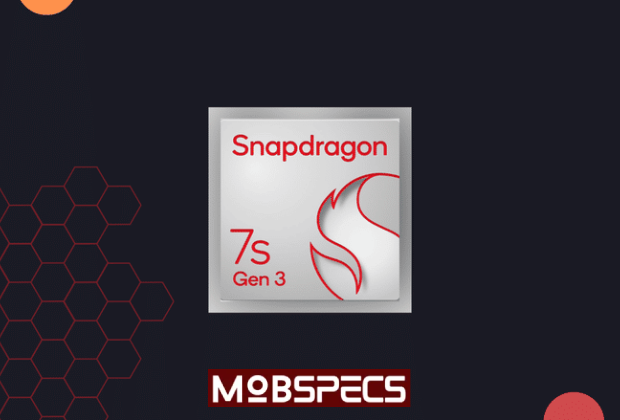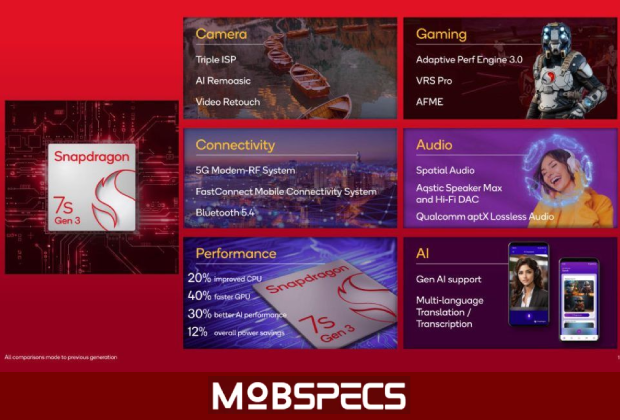
The Qualcomm Snapdragon 7 Gen 3 is a high-performing upper midrange processor designed to power various smartphones released in 2024 by brands such as Motorola, OnePlus, Honor, and others. Developed on TSMC’s 4nm process technology, this chipset features an octa-core configuration with clock speeds reaching up to 2.91 GHz. In this comprehensive review, we’ll examine its full specifications and explore how its performance translates into benchmark scores across multiple testing platforms.
Snapdragon 7 Gen 3 AnTuTu Score Benchmark Overview
The tests presented in this article were conducted on the Motorola Edge 50 Pro, a smartphone powered by the Snapdragon 7 Gen 3. The benchmarks evaluated include AnTuTu, Geekbench, GFXBench, PCMark, and Burnout tests.
Qualcomm Snapdragon 7 Gen 3 AnTuTu Score
AnTuTu is a widely-used benchmarking tool that evaluates the overall performance of a device by analyzing its CPU, GPU, memory, and user experience (UX). The Snapdragon 7 Gen 3 AnTuTu results are as follows:
| Category | Score |
|---|---|
| AnTuTu Overall Score | 827,231 |
| CPU | 256,493 |
| GPU | 247,609 |
| Memory | 156,244 |
| UX | 166,885 |
These results highlight the Snapdragon 7 Gen 3’s well-rounded capabilities in delivering efficient performance across multiple areas, from gaming to multitasking.
Qualcomm Snapdragon 7 Gen 3 Geekbench Score
Geekbench is a benchmarking tool that measures the raw processing power of a chipset’s CPU, focusing on both single-core and multi-core performance. The Snapdragon 7 Gen 3 achieved the following results:
| Test | Score |
| Single-core | 1,142 |
| Multi-core | 3,119 |
The scores reflect the processor’s ability to handle tasks efficiently, whether running single-threaded applications or managing demanding multi-threaded workloads.
Qualcomm Snapdragon 7 Gen 3 GFXBench Score
GFXBench measures the graphical performance of a chipset’s GPU by simulating 3D gaming environments. The Snapdragon 7 Gen 3’s Adreno 720 GPU demonstrated impressive results in the Manhattan and T-Rex tests:
| Test | Frame Rate |
| Manhattan (30 min) | 3,705 frames (60 FPS) |
| T-Rex | 3,352 frames (60 FPS) |
These results indicate that the Adreno 720 GPU is capable of delivering high-quality graphics and smooth frame rates during gaming and other GPU-intensive tasks.
Qualcomm Snapdragon 7 Gen 3 PCMark Score
PCMark evaluates a device’s overall performance by simulating real-world usage scenarios. The tests include performance and battery endurance evaluations. The Snapdragon 7 Gen 3 delivered the following results:
| Test | Score |
| PCMark Performance (10-15 min) | 14,283 |
| PCMark Battery Performance | 12 hours 30 minutes |
Note: The battery performance test was conducted on the Motorola Edge 50 Pro, equipped with a 4,500mAh battery. Results may vary on other devices using the Snapdragon 7 Gen 3.
Qualcomm Snapdragon 7 Gen 3 Burnout Benchmark
The Burnout benchmark assesses a chipset’s stability under sustained workloads, measuring its ability to maintain performance during CPU throttling. Here are the results:
| Parameter | Result |
| Performance under throttling | 69.6% (8 min 32 sec) |
| Temperature after the test | 47.2°C |
These results suggest the Snapdragon 7 Gen 3 maintains decent stability during prolonged heavy usage, although it may generate noticeable heat.
Mobile Phones Featuring Snapdragon 7 Gen 3
The following smartphones are powered by the Qualcomm Snapdragon 7 Gen 3:
- OnePlus Nord CE 4
- Motorola Edge 50 Pro
- Honor 200
- Vivo V30
- Vivo V40
- iQOO Z9s Pro
Each of these devices benefits from the Snapdragon 7 Gen 3’s advanced processing capabilities, making them excellent options for users seeking high performance in midrange smartphones.
Qualcomm Snapdragon 7 Gen 3 Specifications
The Snapdragon 7 Gen 3 boasts an impressive array of technical features designed to deliver superior performance and efficiency. Here’s a detailed breakdown:
| Category | Details |
| Manufacturer | TSMC |
| CPU Cores | Octa-core (8) |
| CPU Structure | 1×2.91 GHz Cortex-X2 |
| 3×2.49 GHz Cortex-A710 | |
| 4×1.8 GHz Cortex-A510 | |
| CPU Architecture | 64-bit |
| Process Node | 4nm |
| GPU | Adreno 720 |
| GPU APIs | OpenGL ES 3.2, Vulkan 1.3 |
| OpenCL 2.0 FP | |
| Memory Type | LPDDR5 |
| Storage Type | UFS 3.1 |
| Display Resolution | WFHD+ (168Hz) or WQHD+ (120Hz) |
| Video Playback | Up to 4K at 60 FPS |
| ISP | Qualcomm Spectra |
| Single Camera | Max 200MP |
| Video Capture | Up to 4K |
| Video Codecs | HDR10+, H.264, H.265, VP8 |
| VP9, HLG | |
| Slow-motion Capture | Up to 1080p at 120 FPS |
| WiFi Support | Wi-Fi 4/5/6/6E |
| Bluetooth | Bluetooth 5.4 |
| Modem | Snapdragon X63 5G |
| Cellular Technology | Sub-6 GHz |
| Satellite Systems | GLONASS, NavIC, Beidou, GPS, |
| QZSS, Galileo | |
| NFC | Supported |
Qualcomm Snapdragon 7s Gen 3: Performance Benchmarks and Specifications
The Qualcomm Snapdragon 7s Gen 3 SoC, succeeding the 7s Gen 2, is poised to power a new generation of mid-range smartphones. Leading the charge is the Redmi Note 14 Pro+, offering a glimpse into the performance potential of this chipset. To gauge its capabilities, we delve into key benchmark scores and explore its specifications.

Snapdragon 7s Gen 3 AnTuTu Score
AnTuTu, a comprehensive benchmarking tool, evaluates a phone’s overall performance across CPU, GPU, memory, and user experience (UX). The Snapdragon 7s Gen 3 achieved an impressive AnTuTu score of 7,25,812. This score highlights the chipset’s robust performance, particularly in CPU (2,49,122) and GPU (1,90,271) domains.
Snapdragon 7s Gen 3 Geekbench Score
Geekbench primarily focuses on CPU performance, providing insights into single-core and multi-core capabilities. The Snapdragon 7s Gen 3 demonstrated a single-core score of 1,168 and a multi-core score of 3,234. These scores underscore the chipset’s ability to handle demanding tasks efficiently.
Beyond synthetic benchmarks, Qualcomm claims a significant performance leap with the 7s Gen 3. It boasts a 20% CPU improvement, a 40% GPU boost, and over 30% enhanced AI performance compared to its predecessor.
Snapdragon 7s Gen 3 PCMark Score
PCMark provides real-world performance insights. In our testing on the Redmi Note 14 Pro+ (equipped with a 6,200mAh battery), the 7s Gen 3 achieved a PCMark performance score of 12,769 in a sustained 10-15 minute workload. The battery life was equally impressive, enduring 13 hours and 44 minutes in the PCMark battery life test.
*Please note that battery life may vary depending on the specific phone model and usage patterns.
Snapdragon 7s Gen 3 Specifications
The Snapdragon 7s Gen 3 is manufactured on a 4nm process by TSMC. It features an octa-core CPU comprising:
- 1x Cortex-A720 core at 2.5 GHz
- 3x Cortex-A720 cores at 2.4 GHz
- 4x Cortex-A520 cores at 1.8 GHz
This powerful CPU architecture, coupled with the Adreno 710 GPU clocked at 940 MHz, enables smooth and responsive performance across various applications and games.
Key Specifications:
- CPU: Octa-core (1x A720 @ 2.5 GHz, 3x A720 @ 2.4 GHz, 4x A520 @ 1.8 GHz)
- GPU: Adreno 710 @ 940 MHz
- Memory: LPDDR5 at 3200 MHz
- Storage: UFS 2.2, UFS 3.1
- Display: Up to FullHD+ at 144Hz
- Connectivity: Wi-Fi 6E, Bluetooth 5.4, 5G (sub-6 GHz, mmWave)
The Snapdragon 7s Gen 3 represents a significant advancement in mid-range smartphone performance. With its impressive AnTuTu score, strong Geekbench results, and robust real-world performance, it promises a smooth and enjoyable user experience for demanding users.
Disclaimer: The benchmark scores and performance observations in this article are based on testing conducted on the Redmi Note 14 Pro+. Actual results may vary depending on the specific phone model, software optimizations, and usage conditions.
Frequently Asked Questions (FAQs)
How good is the Qualcomm Snapdragon 7 Gen 3 processor?
The Snapdragon 7 Gen 3 is an excellent choice for upper midrange smartphones. Based on our tests with the Motorola Edge 50 Pro, it handles day-to-day tasks, browsing, and social media scrolling seamlessly. Gaming performance is smooth, with the phone maintaining optimal performance for the first 40 to 45 minutes before experiencing minor warming.
Who manufactures the Snapdragon 7 Gen 3, and when was it launched?
The Snapdragon 7 Gen 3 is manufactured by TSMC using its advanced 4nm process. It was officially launched in November 2023, marking a significant upgrade in Qualcomm’s midrange lineup.
How good is the Qualcomm Snapdragon 7 Gen 3 processor?
The Snapdragon 7 Gen 3, positioned as an upper midrange chipset, delivers excellent performance for everyday and casual tasks. During our tests with the Motorola Edge 50 Pro, which features this processor, the device handled activities like browsing and social media scrolling seamlessly, with no lag or stuttering. For gaming, the phone offered smooth performance for the first 40 to 45 minutes, after which it became slightly warm.
Who manufactures the Snapdragon 7 Gen 3 and when was it launched?
Built by TSMC using its advanced 4nm process, the Snapdragon 7 Gen 3 was officially launched in November 2023.
In conclusion, the Qualcomm Snapdragon 7 Gen 3 is a powerful and efficient chipset designed for users seeking high performance without venturing into flagship territory. Its excellent benchmark results, coupled with advanced features and compatibility with multiple midrange smartphones, make it a standout choice in its category.
Also Read Below:
https://continent-telecom.com/virtual-number-germany